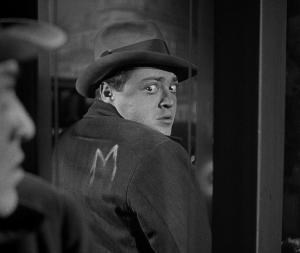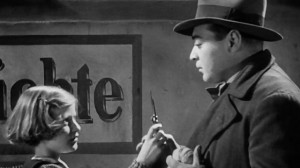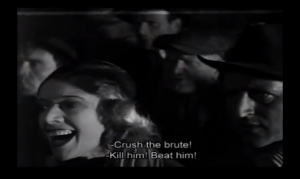M (1931)
Inevitable with new changes in technology, sound entered into the production of films and would forever change how movies were created. As I watched this third movie, I’m aware for the first time of how sound allows another sense to become activated as you are staring at the images flash by. When the two fit together seamlessly, the emotion and tone’s impact strike even deeper.
As the shift from silent to sound took place during the 30’s, this movie serves as a strong intermediate, as the dialogue is spoken in German. While emotion is still told focusing on body language, I now can hear inflection and emphasis in people’s voices. No matter the language, you will always be able to tell when a character is furious or joyous. This allows us, as the audience, to connect to anyone through the medium of film. And while La Passion may had deeper levels of sorrow and sadness, this movie hits so many emotions that I feel like I’m recovering from a roller coaster from its ups and downs.
In M, the “antagonist” kills young girls (never shown on screen). These horrible acts of violence keep the film relevant as children are seen as a image of innocence and purity. We, as a society, want to protect those that can’t protect themselves, so the killer’s actions are seen as absolute scum (even by the perspective of criminals). With concepts this disturbing and somewhat controversial, I’m always interested how the movies are going to present it. Everyone has their own network of interpretations of issues, and while something like violence against children shouldn’t ever be societally acceptable, you don’t want to misrepresent people. I feel that the movie accomplishes this by not demonizing the antagonist completely. Instead, he is shown to be tormented day and night by his own personal demons. In today’s society, he would probably be diagnosed as intensely schizophrenic. However, mental illness wasn’t really properly understood in the early 1900’s, evidenced in how the other characters don’t believe his pleas of insanity. This aspect shows how M was definitely a product of its time, but also was able to produce concepts that seemed very progressive.
The movie M also explores the dangers and unforeseen consquences of “groupthink”. During the paranoia of trying to find the child killer, the individuals in the town point fingers at each other and the smallest alien behavior is seen as incriminating evidence. They find a man answer what the time is to a girl and start to gang up on him. No place is this “groupthink” so explored than in the climax street court scene. Instead of acting in a court, the criminals feel it is their responsibility to hold sentence the killer themselves. Even after the killer shows the utmost remorse, any single outburst from a character in the crowd causes a reaction where all onlookers are screaming for his death. In the end, the killer is only rescued by the lawful nature of the police. Thus, this “groupthink” is seen almost parallel in destructiveness to human life as the killer’s actions.
M is persuasively a film about everyone’s ghosts and the horrors that can unfold if we succumb to them.




This movie sounds like a very interesting film that helps to provide viewers with an accurate depiction of how most people viewed mental illnesses in the 1930s. While this sounds like an excellent movie, I don’t think I would enjoy it for two reasons. First, I have a very short attention span, so reading subtitles for a full-length movie would most likely not hold my attention very well. I also don’t think I would enjoy the context of the film. I’m not a huge fan of suspense, action, or horror movies. While most of the violence happens off screen, it would still be slightly too disturbing for me to watch. I really enjoy your writing style for your passion blog. You have an excellent blend of informative and personal opinions, objective and subjective alike.